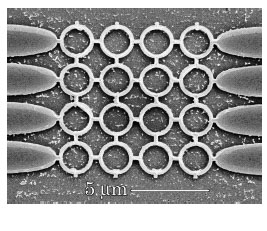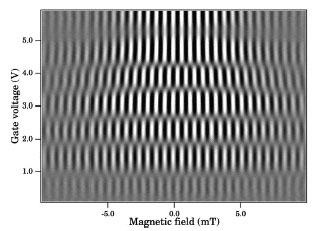Tobias Bergsten1,2, Toshiyuki Kobayashi1,2,
Yoshiaki Sekine1,2, and Junsaku Nitta1,2,3
1Physical Science Laboratory, 2CREST-JST, 3Tohoku University
The device used in this study was fabricated using InAlAs/InGaAs/InP quantum well, where the SOI strength is tunable by gate voltage by more than 3 peVm. To observe the interference of electron waves traveling along a limited path, a ring array was etched out as shown in Fig. 1. The gate electrode is deposited on top of the rings using 50 nm-thick SiO2 as a gate insulator.
The relative phase difference of partial electron waves, which propagate clockwise and counterclockwise in a ring structure, was controlled by the gate voltage (AC effect) as well as the magnetic field (Aharonov-Bohm and Al’tshuler-Aronov-Spivak effect) and measured as a resistance oscillation (Fig. 2). Since the electron is a fermion particle (spin is 1/2), the spin precession of one turn (2π) changes the quantum phase for π. Therefore, the resistance oscillation period with respect to the gate voltage corresponds to the relative spin precession angle of 4π between the two partial waves of an electron traveling opposite directions and coming back to the original position. This shows that we have precise control of the spin precession angle for over 12π. This spin control is essential for the spin-FET and it may also prove important for future quantum computing devices based on spin qubits.
[1] S. Datta and B. Das, Appl. Phys. Lett. 56 (1990) 665.
[2] J. Nitta, T. Akazaki, H. Takayanagi, and T. Enoki, Phys. Rev. Lett.
76 (1997) 1335.
[3] T. Bergsten, T. Kobayashi, Y. Sekine, and J. Nitta, Phys. Rev. Lett.
97 (2006) 196803.
 |
 |
|||||
|
|